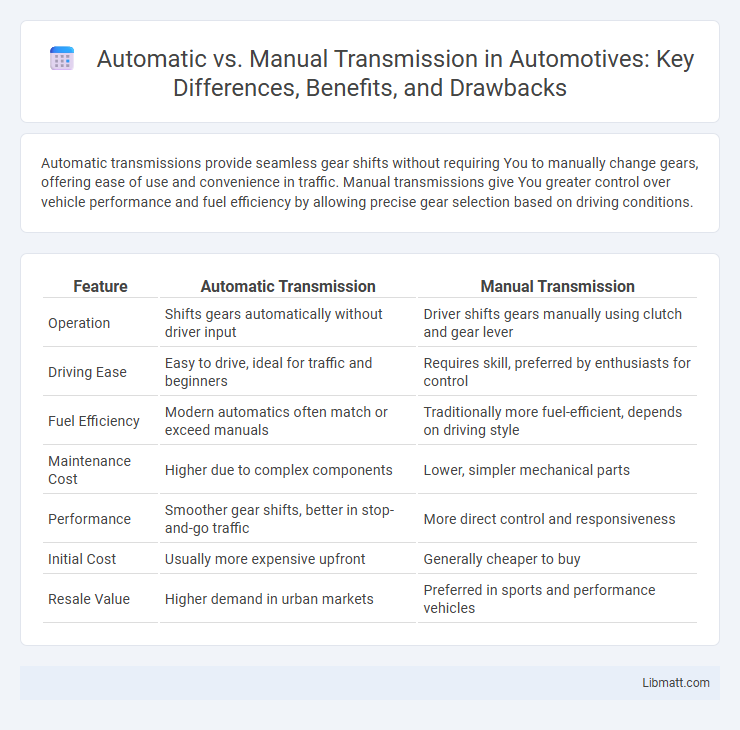Automatic transmissions provide seamless gear shifts without requiring You to manually change gears, offering ease of use and convenience in traffic. Manual transmissions give You greater control over vehicle performance and fuel efficiency by allowing precise gear selection based on driving conditions.
Table of Comparison
| Feature | Automatic Transmission | Manual Transmission |
|---|---|---|
| Operation | Shifts gears automatically without driver input | Driver shifts gears manually using clutch and gear lever |
| Driving Ease | Easy to drive, ideal for traffic and beginners | Requires skill, preferred by enthusiasts for control |
| Fuel Efficiency | Modern automatics often match or exceed manuals | Traditionally more fuel-efficient, depends on driving style |
| Maintenance Cost | Higher due to complex components | Lower, simpler mechanical parts |
| Performance | Smoother gear shifts, better in stop-and-go traffic | More direct control and responsiveness |
| Initial Cost | Usually more expensive upfront | Generally cheaper to buy |
| Resale Value | Higher demand in urban markets | Preferred in sports and performance vehicles |
Introduction to Automatic and Manual Transmissions
Automatic transmissions use a complex system of hydraulics, sensors, and computers to change gears without driver input, providing ease of use and smoother gear shifts. Manual transmissions require the driver to manually engage the clutch and shift gears, offering greater control over the vehicle's power and fuel efficiency. Understanding the key differences between automatic and manual transmissions helps drivers choose the best option for their driving style and needs.
How Automatic Transmissions Work
Automatic transmissions use a complex system of hydraulic controls, torque converters, and planetary gearsets to automatically change gear ratios based on vehicle speed and engine load. The torque converter replaces the clutch in manual systems, allowing smooth acceleration without manual gear shifts. Understanding how automatic transmissions work can help you appreciate their ability to optimize fuel efficiency and driving comfort.
How Manual Transmissions Operate
Manual transmissions operate by engaging and disengaging gears through a clutch pedal and gear stick manipulated by the driver. The clutch pedal temporarily disconnects the engine from the drivetrain, allowing the driver to shift gears smoothly. This system provides direct control over gear selection, enhancing driving precision and fuel efficiency.
Key Differences Between Automatic and Manual
Automatic transmissions use a complex system of hydraulics and electronics to change gears without driver input, enhancing ease of use and convenience in stop-and-go traffic. Manual transmissions require the driver to manually engage the clutch and shift gears, offering greater control and often better fuel efficiency. Key differences include the level of driver involvement, gear-shifting mechanisms, and overall driving experience, with automatic transmissions prioritizing simplicity and manuals emphasizing precision and engagement.
Performance Comparison: Automatic vs Manual
Manual transmissions typically offer better performance due to direct driver control over gear selection, enabling faster acceleration and more precise power management. Automatic transmissions have improved with technologies like dual-clutch systems, providing quicker gear shifts and smoother operation but may still lag slightly in efficiency and responsiveness. Performance metrics such as 0-60 mph times and fuel economy often favor manual systems in sports cars, while automatics prioritize convenience and consistency in everyday driving.
Fuel Efficiency: Which is Better?
Manual transmissions often provide better fuel efficiency because they allow drivers to control gear shifts and engine RPM more precisely, reducing fuel consumption, especially in city driving. Automatic transmissions have improved significantly with technologies like CVT and dual-clutch systems, narrowing the fuel economy gap by optimizing shift patterns for efficiency. Your choice depends on driving habits, but manual transmissions typically offer superior fuel economy when properly driven.
Maintenance and Repair Costs
Automatic transmissions typically incur higher maintenance and repair costs due to their complex hydraulic systems and electronic controls. Manual transmissions often have simpler mechanical components, resulting in lower repair expenses but may require more frequent clutch replacements. Understanding these differences can help you manage your vehicle's long-term maintenance budget effectively.
Driving Experience and Control
Automatic transmissions offer a smoother and more convenient driving experience by eliminating the need for manual gear changes, allowing drivers to focus more on the road. Manual transmissions provide greater control over gear selection and engine power, enhancing driver engagement and performance, especially in challenging driving conditions. Drivers seeking a dynamic and responsive connection with their vehicle often prefer manual transmissions, while those valuing ease and comfort favor automatic systems.
Pros and Cons of Each Transmission Type
Automatic transmissions offer ease of use and smoother shifting, making them ideal for city driving and beginners, but they typically have lower fuel efficiency and higher maintenance costs compared to manuals. Manual transmissions provide better control and improved fuel economy, appealing to driving enthusiasts, yet they require more skill and can cause driver fatigue in heavy traffic. Your choice depends on whether you prioritize convenience and comfort or enhanced control and performance.
Choosing the Right Transmission for Your Needs
Choosing the right transmission depends on your driving habits and vehicle preferences. Automatic transmissions offer ease of use and smooth shifting, ideal for city driving and stop-and-go traffic, while manual transmissions provide greater control and better fuel efficiency, preferred by enthusiasts and those seeking an engaging driving experience. Consider factors like maintenance costs, fuel economy, and your comfort level with operating a clutch to make the best choice for your needs.
Automatic vs Manual Transmission Infographic

 libmatt.com
libmatt.com